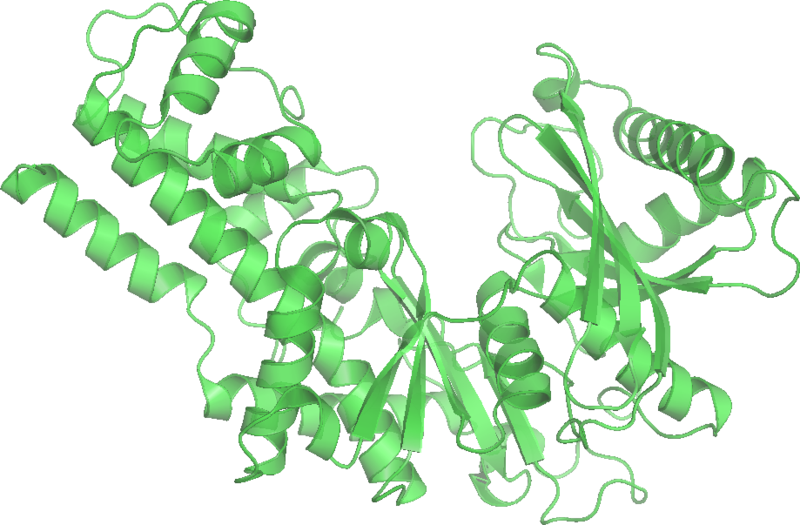Glycolysis
|
WikiDoc Resources for Glycolysis |
|
Articles |
|---|
|
Most recent articles on Glycolysis |
|
Media |
|
Evidence Based Medicine |
|
Clinical Trials |
|
Ongoing Trials on Glycolysis at Clinical Trials.gov Clinical Trials on Glycolysis at Google
|
|
Guidelines / Policies / Govt |
|
US National Guidelines Clearinghouse on Glycolysis
|
|
Books |
|
News |
|
Commentary |
|
Definitions |
|
Patient Resources / Community |
|
Patient resources on Glycolysis Discussion groups on Glycolysis Patient Handouts on Glycolysis Directions to Hospitals Treating Glycolysis Risk calculators and risk factors for Glycolysis
|
|
Healthcare Provider Resources |
|
Causes & Risk Factors for Glycolysis |
|
Continuing Medical Education (CME) |
|
International |
|
|
|
Business |
|
Experimental / Informatics |
Editor-In-Chief: C. Michael Gibson, M.S., M.D. [1]
- See also: Gluconeogenesis, which carries out a process wherein glucose is synthesized rather than catabolized.
Overview
Glycolysis is the sequence of reactions that converts glucose into pyruvate with the concomitant production of a relatively small amount of ATP. The word is derived from Greek γλυκύς (sweet) and λύσις (letting loose).
It is the initial process of most carbohydrate catabolism, and it serves three principal functions:
- The generation of high-energy molecules (ATP and NADH) as cellular energy sources as part of aerobic respiration and anaerobic respiration, that is, in the former process, oxygen is present, and, in the latter, oxygen is not present
- Production of pyruvate for the citric acid cycle as part of aerobic respiration
- The production of a variety of six- and three-carbon intermediate compounds, which may be removed at various steps in the process for other cellular purposes.
As the foundation of both aerobic and anaerobic respiration, glycolysis is the archetype of universal metabolic processes known and occurring (with variations) in many types of cells in nearly all organisms. Glycolysis, through anaerobic respiration, is the main energy source in many prokaryotes, eukaryotic cells devoid of mitochondria (e.g., mature erythrocytes) and eukaryotic cells under low-oxygen conditions (e.g., heavily-exercising muscle or fermenting yeast).
In eukaryotes and prokaryotes, glycolysis takes place within the cytosol of the cell. In plant cells, some of the glycolytic reactions are also found in the Calvin-Benson cycle, which functions inside the chloroplasts. The wide conservation includes the most phylogenetically deep-rooted extant organisms, and thus it is considered to be one of the most ancient metabolic pathways.[1]
The most common and well-known type of glycolysis is the Embden-Meyerhof pathway, initially explained by Gustav Embden and Otto Meyerhof. The term can be taken to include alternative pathways, such as the Entner-Doudoroff Pathway. However, glycolysis will be used here as a synonym for the Embden-Meyerhof pathway.
The overall reaction of glycolysis is:
| D-Glucose | Pyruvate | ||||

|
+ 2 NAD+ + 2 ADP + 2 Pi | 
|
2 | 
|
+ 2 NADH + 2 H+ + 2 ATP + 2 H2O |
The products all have vital cellular uses:
- ATP provides an energy source for many cellular functions.
- NADH + H+ provides reducing power for other metabolic pathways or further ATP synthesis.
- Pyruvate is used in the citric acid cycle in aerobic respiration to produce more ATP, or is converted to other small carbon molecules in anaerobic respiration.
For simple anaerobic fermentations, the metabolism of one molecule of glucose to two molecules of pyruvate has a net yield of two molecules of ATP. Most cells will then carry out further reactions to 'repay' the used NAD+ and produce a final product of ethanol or lactic acid. Many bacteria use inorganic compounds as hydrogen acceptors to regenerate the NAD+.
Cells performing aerobic respiration synthesize much more ATP, but not as part of glycolysis. These further aerobic reactions use pyruvate and NADH + H+ from glycolysis. Eukaryotic aerobic respiration produces approximately 34 additional molecules of ATP for each glucose molecule, however most of these are produced by a vastly different mechanism to the substrate-level phosphorylation in glycolysis.
The lower energy production, per glucose, of anaerobic respiration relative to aerobic respiration, results in greater flux through the pathway under hypoxic (low-oxygen) conditions, unless alternative sources of anerobically-oxidizable substrates, such as fatty acids, are found.
ATP
ADP
ATP
ADP
+ +
NAD++ Pi
NADH + H+
NAD++ Pi
NADH + H+ H2O
H2O ADP
ATP
2 × Pyruvate 2 × File:Pyruvat.svg
|
Discovery
The first formal studies of the glycolytic process were initiated in 1860 when Louis Pasteur discovered that microorganisms are responsible for fermentation, and in 1897 when Eduard Buchner found certain cell extracts can cause fermentation. The next major contribution was from Arthur Harden and William Young in 1905 who determined that a heat-sensitive high-molecular-weight subcellular fraction (the enzymes) and a heat-insensitive low-molecular-weight cytoplasm fraction (ADP, ATP and NAD+ and other cofactors) are required together for fermentation to proceed. The details of the pathway itself were eventually determined by 1940, with a major input from Otto Meyerhof and some years later by Luis Leloir. The biggest difficulties in determining the intricacies of the pathway were due to the very short lifetime and low steady-state concentrations of the intermediates of the fast glycolytic reactions.
Sequence of reactions
These are the major reactions, through which most glucose will pass. There are additional alternative pathways and regulatory products, which are not shown here.
Preparatory phase
The first five steps are regarded as the preparatory (or investment) phase since they consume energy to convert the glucose into two three-carbon sugar phosphates (G3P).
| The first step in glycolysis is phosphorylation of glucose by a family of enzymes called hexokinases to form glucose 6-phosphate. This reaction consumes ATP, but it acts to keep the glucose concentration low, promoting continuous transport of glucose into the cell through the plasma membrane transporters. In addition, it blocks the glucose from leaking out - the cell lacks transporters for glucose 6-phosphate. Glucose may alternatively be from the hydrolysis of intracellular starch or glycogen.
In animals, an isozyme of hexokinase called glucokinase is also used in the liver, which has a much lower affinity for glucose (Km in the vicinity of normal glycemia), and differs in regulatory properties. The different substrate affinity and alternate regulation of this enzyme are a reflection of the role of the liver in maintaining blood sugar levels. Cofactors: Mg2+ |
| ||||||||||||||||||||
| G6P is then rearranged into fructose 6-phosphate by glucose phosphate isomerase. Fructose can also enter the glycolytic pathway by phosphorylation at this point.
The change in structure is an isomerization, in which the G6P has been converted to fructose 6-phosphate, (F6P). The reaction requires an enzyme, phosphohexose isomerase, to proceed. This reaction is freely reversible under normal cell conditions. However, it is often driven forward because of a low concentration of fructose 6-phosphate, which is constantly consumed during the next step of glycolysis. Under conditions of high fructose 6-phosphate concentration this reaction readily runs in reverse. This phenomenon can be explained through Le Chatelier's Principle. |
| ||||||||||||||||||||
| The energy expenditure of another ATP in this step is justified in 2 ways: The glycolytic process (up to this step) is now irreversible, and the energy supplied destabilizes the molecule. Because the reaction catalyzed by PFK-1 is energetically very favorable, it is essentially irreversible, and a different pathway must be used to do the reverse conversion during gluconeogenesis. This makes the reaction a key regulatory point (see below). [During fasting, the concentration of fructose 2,6-bisphosphate (an allosteric activator of PFK1) is low, such that PFK1 activity is reduced. This leads to an increase of flux through the gluconeogenesis pathway.]
Cofactors: Mg2+ |
| ||||||||||||||||||||
| Destabilizing the molecule in the previous reaction allows the hexose ring to be split by aldolase into two triose sugars, dihydroxyacetone phosphate and glyceraldehyde 3-phosphate. | Template:Complex Enzymatic Reaction |
| Triosephosphate isomerase rapidly interconverts dihydroxyacetone phosphate with glyceraldehyde 3-phosphate (GADP) that proceeds further into glycolysis. This is advantageous, as it directs dihydroxyacetone phosphate down the same pathway as glyceraldehyde 3-phosphate, simplifying regulation. |
| ||||||||||||||||||||
- Note - The third step can also be catalysed by pyrophosphate dependent phosphofructokinase (PFP or PPi-PFK). This enzyme catalyses the same reaction as PFK1 (also known as ATP-PFK), but uses pyrophosphate (PPi) as a phosphate donor, instead of ATP. It is a reversible reaction, increasing the flexibility of glycolytic metabolism. This enzyme is not found in animal cells, but is found in most plants, some bacteria, archaea, and protists.[2] A rarer ADP dependent PFK enzyme (ADP-PFK) variant has been identified in archaean species.[3]
Pay-off phase
The second half of glycolysis is known as the pay-off phase, characterised by a net gain of the energy-rich molecules ATP and NADH. Since glucose leads to two triose sugars in the preparatory phase, each reaction in the pay-off phase occurs twice per glucose molecule. This yields 2 NADH molecules and 4 ATP molecules, leading to a net gain of 2 NADH molecules and 2 ATP molecules from the glycolytic pathway per glucose.
| The triose sugars are dehydrogenated and inorganic phosphate is added to them, forming 1,3-bisphosphoglycerate.
The hydrogen is used to reduce two molecules of [[NAD+]], a hydrogen carrier, to give NADH + H+. |
| ||||||||||||||||||||
| This step is the enzymatic transfer of a phosphate group from 1,3-bisphosphoglycerate to ADP by phosphoglycerate kinase, forming ATP and 3-phosphoglycerate. At this step, glycolysis has reached the break-even point: 2 molecules of ATP were consumed, and 2 new molecules have now been synthesized. This step, one of the two substrate-level phosphorylation steps, requires ADP; thus, when the cell has plenty of ATP (and little ADP), this reaction does not occur. Because ATP decays relatively quickly when it is not metabolized, this is an important regulatory point in the glycolytic pathway.
Cofactors: Mg2+ |
| ||||||||||||||||||||
| Phosphoglycerate mutase now forms 2-phosphoglycerate. Notice that this enzyme is a mutase and not an isomerase. Whereas an isomerase changes the oxidation state of the carbons of the compound, a mutase does not. |
| ||||||||||||||||||||
| Enolase next forms phosphoenolpyruvate from 2-phosphoglycerate.
Cofactors: 2 Mg2+: one "conformational" ion to coordinate with the carboxylate group of the substrate, and one "catalytic" ion which participates in the dehydration. |
| ||||||||||||||||||||
| A final substrate-level phosphorylation now forms a molecule of pyruvate and a molecule of ATP by means of the enzyme pyruvate kinase. This serves as an additional regulatory step, similar to the phosphoglycerate kinase step.
Cofactors: Mg2+ |
| ||||||||||||||||||||
Oxidative decarboxylation
| This reaction is not technically a reaction of glycolysis, but is very common in most organisms as a link to the citric acid cycle. This reaction is carried out in the mitochondria, unlike the reactions of glycolysis which are cytosolic.
The addition of Coenzyme A (CoA) to the pyruvate traps the product, acetyl CoA, within the mitochondria. This is analogous to the phosphorylation of glucose in the first step of glycolysis. |
| ||||||||||||||||||||
Regulation
- See also: Gluconeogenesis
The flux through the glycolytic pathway is adjusted in response to conditions both inside and outside the cell. The rate is regulated to meet two major cellular needs: (1) the production of ATP, and (2) the provision of building blocks for biosynthetic reactions. In some cases the pathway may be halted entirely to allow the reverse process gluconeogenesis. In glycolysis, the reactions catalyzed by hexokinase, phosphofructokinase, and pyruvate kinase are effectively irreversible in most organisms. In metabolic pathways, such enzymes are potential sites of control, and all these three enzymes serve this purpose in glycolysis.
There are several different ways to regulate the activity of an enzyme. An immediate form of control is feedback via allosteric effectors or by covalent modification. A slower form of control is transcriptional regulation that controls the amounts of these important enzymes.
Hexokinase

Hexokinase is inhibited by glucose-6-phosphate (G6P), the product it forms through the ATP-driven phosphorylation. This is necessary to prevent an accumulation of G6P in the cell when flux through the glycolytic pathway is low. Glucose will enter the cell, but, since the hexokinase is not active, it can readily diffuse back to the blood through the glucose transporter in the plasma membrane. If hexokinase remained active during low glycolytic flux, the G6P would accumulate and the extra solute would cause the cells to enlarge due to osmosis.
In animals, regulation of blood glucose levels by the liver is a vital part of homeostasis. In liver cells, any extra G6P is stored as glycogen. In these cells, hexokinase is not expressed; instead glucokinase catalyses the phosphorylation of glucose to G6P. This enzyme is not inhibited by high levels of G6P, and glucose can still be converted to G6P and then be stored as glycogen. This is important when blood glucose levels are high. During hypoglycemia, the glycogen can be converted back to G6P and then converted to glucose by a liver-specific enzyme glucose 6-phosphatase. This reverse reaction is an important role of liver cells to maintain blood sugars levels during fasting. This is critical for neuron function, since they can use only glucose as an energy source.
Phosphofructokinase

Phosphofructokinase is an important control point in the glycolytic pathway, since it is immediately downstream of the entry points for hexose sugars.
High levels of ATP inhibit the PFK enzyme by lowering its affinity for F6P. ATP causes this control by binding to a specific regulatory site that is distinct from the catalytic site. This is a good example of allosteric control. AMP can reverse the inhibitory effect of ATP. A consequence is that PFK is tightly controlled by the ratio of ATP/AMP in the cell. This makes sense, because these molecules are direct indicators of the energy charge in the cell.
Since glycolysis is also a source of carbon skeletons for biosynthesis, a negative feedback control to glycolysis from the carbon skeleton pool is useful. Citrate is an example of a metabolite that regulates phosphofructokinase by enhancing the inhibitory effect of ATP. Citrate is an early intermediate in the citric acid cycle, and a high level means that biosynthetic precursors are abundant.
Low pH also inhibits phosphofructokinase activity and prevents the excessive rise of lactic acid during anaerobic conditions that could otherwise cause a drop in blood pH (acidosis), (a potentially life-threatening condition).
Fructose 2,6-bisphosphate (F2,6BP) is a potent activator of phosphofructokinase (PFK-1) that is synthesised when F6P is phosphorylated by a second phosphofructokinase (PFK2). This second enzyme is inactive when cAMP is high, and links the regulation of glycolysis to hormone activity in the body. Both glucagon and adrenalin cause high levels of cAMP in the liver. The result is lower levels of liver fructose 2,6-bisphosphate such that gluconeogenesis (glycolysis in reverse) is favored. This is consistent with the role of the liver in such situations, since the response of the liver to these hormones is to releases glucose to the blood.
Pyruvate kinase and phosphoglycerate kinase

Pyruvate kinase and phosphoglycerate kinase catalyze the two substrate-level phosphorylation steps, and produce ATP from ADP. The requirement of ADP to carry out this reaction provides regulation, as, when the cell has plenty of ATP, it will have little ADP so this reaction is unable to happen. ATP decays relatively quickly, even when not used as an energy source; these stages provide the required simple and fast regulation of ATP levels.
This control is accentuated, as, after the formation of F1,6bP, many of the glycolysis reactions are energetically unfavorable. The only reactions that are favorable are these two substrate-level phosphorylation steps. These two reactions pull the glycolytic pathway to completion when ADP is low and ATP is required.
Post-glycolysis processes
The ultimate fate of pyruvate and NADH produced in glycolysis depends upon the organism and the conditions, most notably the presence or absence of oxygen and other external electron acceptors. In addition, not all carbon entering the pathway leaves as pyruvate and may be extracted at earlier stages to provide carbon compounds for other pathways.
Aerobic respiration
- Main article: Aerobic respiration
In aerobic organisms, pyruvate typically goes through a conversion step from pyruvate to Acetyl CoA, in order to enter the mitochondria, where it is fully oxidized to carbon dioxide and water by pyruvate decarboxylase (oxidative decarboxylation) and the set of enzymes of the citric acid cycle. The products of pyruvate are sequentially dehydrogenated as they pass through the cycle, powering the reduction of NAD+ to NADH. In turn, the NADH is ultimately oxidized by an electron transport chain, using oxygen as final electron acceptor to produce a large amount of ATP via the action of the ATP synthase complex, a process known as oxidative phosphorylation. A small amount of ATP is also produced by substrate-level phosphorylation during the citric acid cycle.
Anaerobic respiration
- Main article: Anaerobic respiration
In animals, including humans, metabolism is primarily aerobic. However, under hypoxic (or partially-anaerobic) conditions, for example, in overworked muscles that are starved of oxygen or in infracted heart muscle cells, pyruvate is converted to lactate by anaerobic respiration (also known as fermentation). This is a solution to maintaining the metabolic flux through glycolysis in response to an anaerobic or severely-hypoxic environment. In many tissues, this is a cellular last resort for energy, and most animal tissue cannot maintain anaerobic respiration for an extended length of time. Many single cellular organisms use anaerobic respiration only as an energy source.
Glycolysis is insufficient for anaerobic respiration, as it does not regenerate NAD+ from the NADH + H+ it produces. It is therefore critical for an anaerobic or hypoxic cell to carry out the additional steps of lactate or alcohol production to regenerate NAD+ that is required for glycolysis to proceed. This is important for normal cellular function, as glycolysis is the only source of ATP in anaerobic or severely-hypoxic conditions.
There are several types of anaerobic respiration wherein pyruvate and NADH are anaerobically metabolized to yield any of a variety of products with an organic molecule acting as the final hydrogen acceptor. For example, the bacteria involved in making yogurt simply reduce pyruvate to lactic acid, whereas yeast produces ethanol and carbon dioxide. Anaerobic bacteria are capable of using a wide variety of compounds, other than oxygen, as terminal electron acceptors in respiration: nitrogenous compounds (such as nitrates and nitrites), sulphur compounds (such as sulphates, sulphites, sulphur dioxide, and elemental sulphur), carbon dioxide, iron compounds, manganese compounds, cobalt compounds, and uranium compounds.
Intermediates for other pathways
This article concentrates on the catabolic role of glycolysis with regard to converting potential chemical energy to usable chemical energy during the oxidation of glucose to pyruvate. However, many of the metabolites in the glycolytic pathway are also used by anabolic pathways, and, as a consequence, flux through the pathway is critical to maintain a supply of carbon skeletons for biosynthesis.
These metabolic pathways are all strongly reliant on glycolysis as a source of metabolites:
- Gluconeogenesis
- Lipid metabolism
- Pentose phosphate pathway
- Citric acid cycle, which in turn leads to:
- Amino acid synthesis
- Nucleotide synthesis
- Tetrapyrrole synthesis
From an energy perspective, NADH is either recycled to NAD+ during anaerobic conditions, to maintain the flux through the glycolytic pathway, or used during aerobic conditions to produce more ATP by oxidative phosphorylation. From an anabolic metabolism perspective, the NADH has a role to drive synthetic reactions, doing so by directly or indirectly reducing the pool of NADP+ in the cell to NADPH, which is another important reducing agent for biosynthetic pathways in a cell.
Glycolysis in disease
Genetic diseases
Glycolytic mutations are generally rare due to importance of the metabolic pathway, however some mutations are seen.
In cancer
Malignant rapidly-growing tumor cells typically have glycolytic rates that are up to 200 times higher than those of their normal tissues of origin. There are two common explanations. The classical explanation is that there is poor blood supply to tumors causing local depletion of oxygen. There is also evidence that attributes some of these high aerobic glycolytic rates to an overexpressed form of mitochondrially-bound hexokinase[4] responsible for driving the high glycolytic activity. This phenomenon was first described in 1930 by Otto Warburg, and hence it is referred to as the Warburg effect. Warburg hypothesis claims that cancer is primarily caused by dysfunctionality in mitochondrial metabolism, rather than because of uncontrolled growth of cells. There is ongoing research to affect mitochondrial metabolism and treat cancer by starving cancerous cells in various new ways, including a ketogenic diet.
This high glycolysis rate has important medical applications, as high aerobic glycolysis by malignant tumors is utilized clinically to diagnose and monitor treatment responses of cancers by imaging uptake of 2-18F-2-deoxyglucose (a radioactive modified hexokinase substrate) with positron emission tomography (PET).[5][6]
Alternative nomenclature
Some of the metabolites in glycolysis have alternative names and nomenclature. In part, this is because some of them are common to other pathways, such as the Calvin cycle.
| This article | Alternative names | Alternative nomenclature | ||
|---|---|---|---|---|
| 1 | glucose | Glc | dextrose | |
| 3 | fructose 6-phosphate | F6P | ||
| 4 | fructose 1,6-bisphosphate | F1,6BP | fructose 1,6-diphosphate | FBP, FDP, F1,6DP |
| 5 | dihydroxyacetone phosphate | DHAP | glycerone phosphate | |
| 6 | glyceraldehyde 3-phosphate | GADP | 3-phosphoglyceraldehyde | PGAL, G3P, GALP,GAP |
| 7 | 1,3-bisphosphoglycerate | 1,3BPG | glycerate 1,3-bisphosphate, glycerate 1,3-diphosphate, 1,3-diphosphoglycerate |
PGAP, BPG, DPG |
| 8 | 3-phosphoglycerate | 3PG | glycerate 3-phosphate | PGA, GP |
| 9 | 2-phosphoglycerate | 2PG | glycerate 2-phosphate | |
| 10 | phosphoenolpyruvate | PEP | ||
| 11 | pyruvate | Pyr | pyruvic acid | |
See also
External links
- The Glycolytic enzymes in Glycolysis at Protein Data Bank
- Glycolytic cycle with animations at wdv.com
- Metabolism, Cellular Respiration and Photosynthesis - The Virtual Library of Biochemistry and Cell Biology at biochemweb.org
- notes on glycolysis at rahulgladwin.com
- The chemical logic behind glycolysis at ufp.pt
- Expasy biochemical pathways poster at ExPASy
- Template:MedicalMnemonics
References
- ↑ Romano AH, Conway T. (1996) Evolution of carbohydrate metabolic pathways. Res Microbiol. 147(6-7):448-55 PMID 9084754
- ↑ Reeves, R. E. (1974). "Pyrophosphate: D-fructose 6-phosphate 1-phosphotransferase. A new enzyme with the glycolytic function 6-phosphate 1-phosphotransferase". J Biol Chem. 249: 7737–7741. PMID 4372217. Unknown parameter
|coauthors=ignored (help) - ↑ Selig, M. (1997). "Comparative analysis of Embden-Meyerhof and Entner-Doudoroff glycolytic pathways in hyperthermophilic archaea and the bacterium Thermotoga". Arch Microbiol. 167: 217–232. PMID 9075622. Unknown parameter
|coauthors=ignored (help) - ↑ "High Aerobic Glycolysis of Rat Hepatoma Cells in Culture: Role of Mitochondrial Hexokinase -- Bustamante and Pedersen 74 (9): 3735 -- Proceedings of the National Academy of Sciences". Retrieved December 5. Unknown parameter
|accessyear=ignored (|access-date=suggested) (help); Check date values in:|accessdate=(help) - ↑ "PET Scan: PET Scan Info Reveals ..." Retrieved December 5. Unknown parameter
|accessyear=ignored (|access-date=suggested) (help); Check date values in:|accessdate=(help) - ↑ "4320139 549..559" (PDF). Retrieved December 5. Unknown parameter
|accessyear=ignored (|access-date=suggested) (help); Check date values in:|accessdate=(help)









